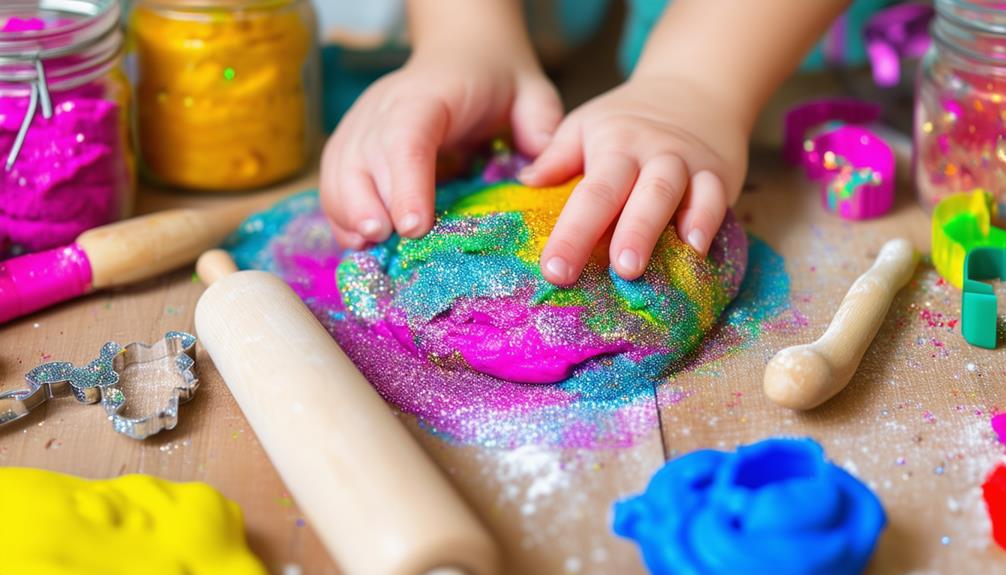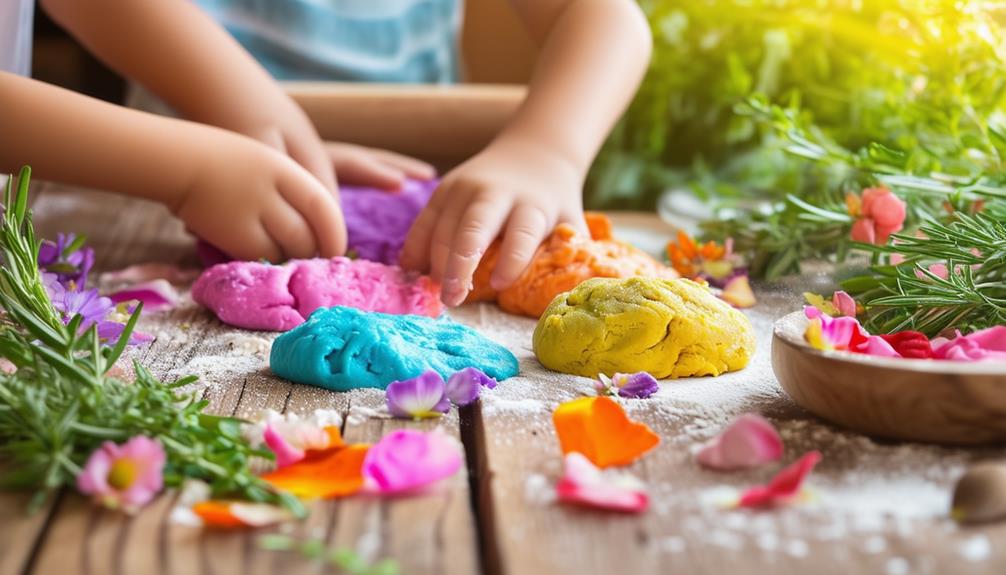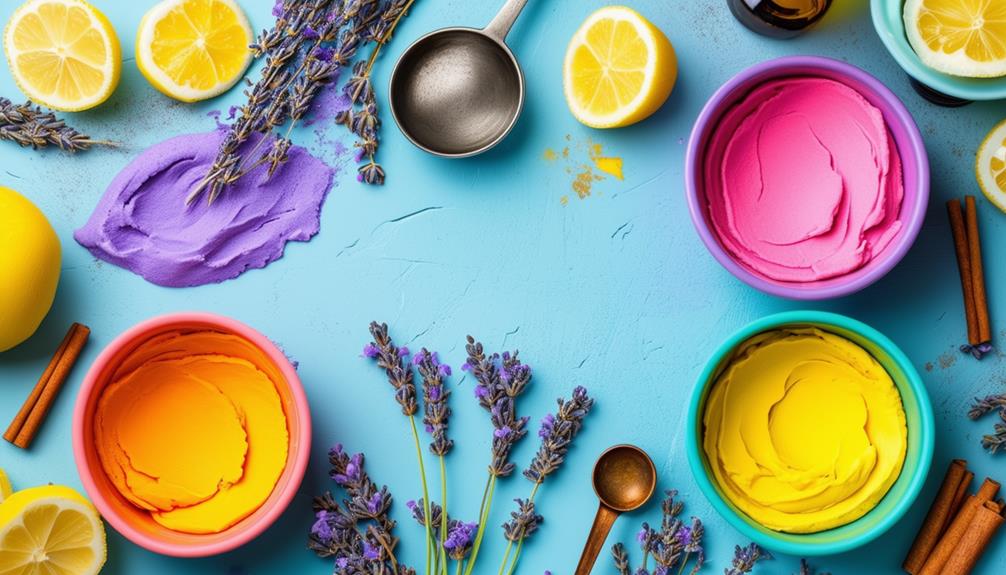How to Make a Safe Playdough?
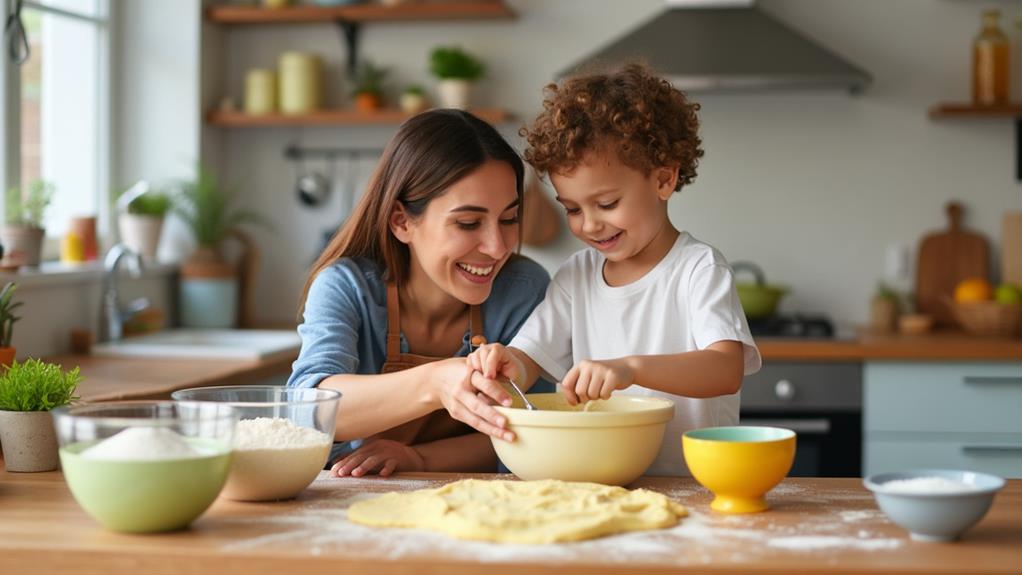
Creating safe playdough for kids involves careful consideration of both the ingredients and the preparation process. Start with common kitchen items like flour, salt, and cream of tartar. Mix these with warm water and optional food coloring to produce a fun, non-toxic dough. For enhanced safety and durability, you can explore alternative ingredients and techniques. Want to perfect your homemade playdough? Follow these steps and tips to ensure it is both enjoyable and safe.
Ingredients Needed
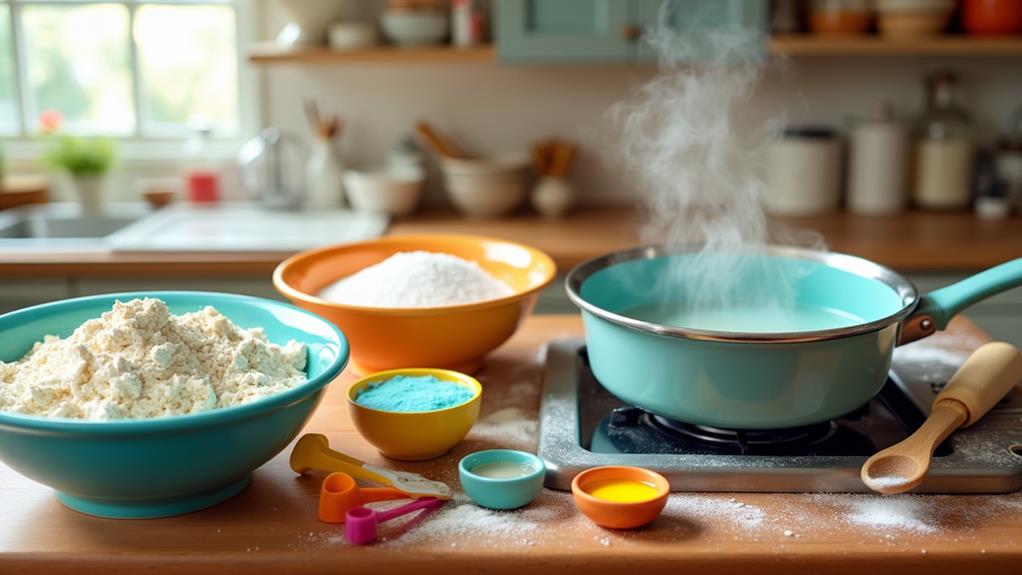
To make safe playdough, gather these simple ingredients commonly found in your kitchen:
- 2 cups of all-purpose flour: This will serve as the base.
- 1 cup of salt: Adds texture and deters tasting due to its high sodium content.
- 2 tablespoons of cream of tartar: Enhances elasticity and playability.
- 2 cups of warm water: Helps combine the ingredients smoothly.
- Optional: Non-toxic food coloring: Adds color to the dough.
With these ingredients, you'll be able to create a safe and enjoyable playdough for your children.
Step-by-Step Instructions
In a large mixing bowl, combine 2 cups of all-purpose flour, 1 cup of salt, and 2 tablespoons of cream of tartar. This forms the base of your play dough recipe. In a separate bowl, mix 2 cups of warm water with food coloring if you desire to add color to your dough. Gradually add the water mixture to the dry ingredients while stirring continuously to prevent lumps.
Once the mixture thickens, transfer it to a pan over medium heat. Stir continuously to ensure the dough doesn't stick to the pan. As it forms a cohesive mass and pulls away from the sides, remove it from the heat.
Allow the dough to cool slightly until it's safe to handle. Knead the dough by hand until it becomes smooth and non-sticky to achieve the right texture.
Alternative Ingredients

Ever wondered how to make playdough even safer for little ones? By using alternative ingredients, you can create a non-toxic, fun, and colorful experience for your child. Start with 1 cup of all-purpose flour and 1 cup of cornstarch. These ingredients ensure a soft and moldable texture without relying on traditional additives like cream of tartar. For added safety, incorporate 2 tablespoons of vegetable oil, which helps improve the consistency.
If you're concerned about preservatives, adding 2 tablespoons of lime juice is a natural way to prolong the playdough's shelf life while keeping it safe for taste testing. Avoid using salt in your recipe, especially for babies and toddlers, to minimize choking hazards. This no-salt approach keeps the dough just as enjoyable and manageable for your little one.
To make the playdough visually appealing, use natural food coloring. This avoids introducing harmful chemicals while still providing lively colors that captivate a child's attention. These alternative ingredients ensure your homemade playdough is not only safe but also enjoyable for your child, making playtime fun and worry-free.
Storage Tips
To keep your playdough soft and fresh, store it in an airtight container or zip-top bag. Refrigerating it can extend its life, especially during warmer months. Make sure to wrap it tightly before storing to maintain its quality.
Airtight Container Benefits
Storing playdough in an airtight container offers multiple benefits that help maintain its quality and extend its usability. Sealing homemade playdough properly prevents moisture loss, ensuring it stays soft and pliable, which is crucial for an enjoyable play experience.
Using an airtight container can extend the playdough's shelf life to up to three months, making it a cost-effective option by reducing the need for frequent remakes. These containers also help maintain a consistent texture, preventing the dough from drying out or becoming too sticky.
Additionally, airtight containers protect playdough from environmental contaminants, keeping it safe and clean for children. This is particularly important since kids often put their hands and toys in their mouths, making hygiene a top priority.
Remember to label your containers with the date of storage. This simple step helps you track the freshness of the playdough and reminds you when it might be time for a replacement.
Refrigeration for Freshness
Refrigerating homemade playdough significantly extends its shelf life, keeping it fresh and malleable for up to six months. Before storing, ensure the playdough is completely cooled to maintain moisture levels and prevent condensation, which can make it sticky. Use airtight containers or plastic zip bags for best results.
Refrigeration helps maintain the playdough's texture. Always check for signs of spoilage, such as unusual smell or texture, before use. If the playdough becomes sticky, a light dusting of flour can restore its consistency before storing again.
Benefits of Playdough
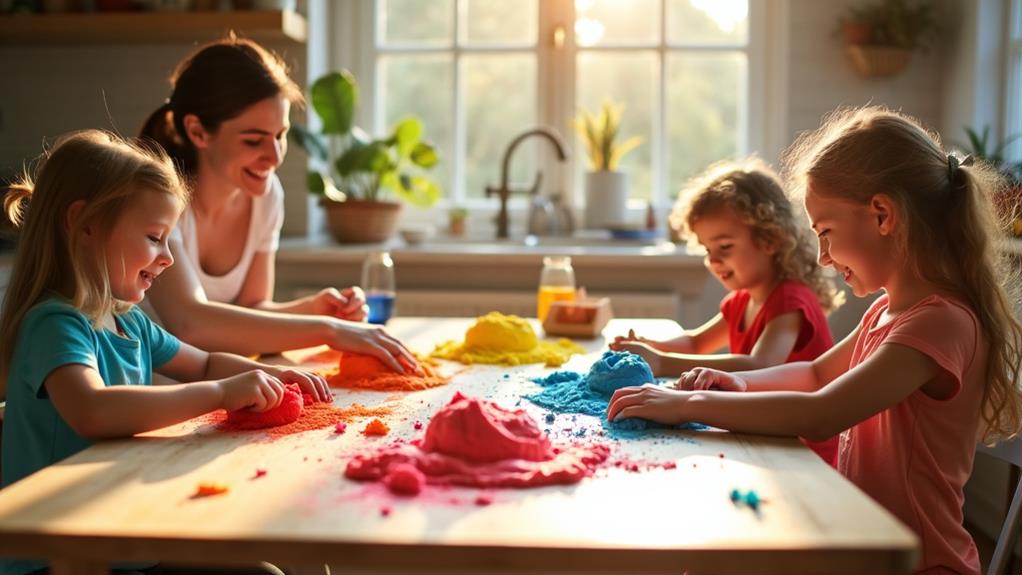
Introducing playdough to your child provides a valuable tool for enhancing fine motor skills and fostering creativity. As they knead, roll, and shape the dough, they develop hand-eye coordination and muscle strength. Additionally, playdough's versatility allows your child to express their imagination by creating a variety of shapes and figures.
Enhances Fine Motor Skills
Playing with playdough offers a fun and effective way for children to develop their fine motor skills. Manipulating and shaping the material strengthens hand muscles and improves dexterity. Activities like rolling, squishing, and pinching enhance coordination and control.
Key benefits of playdough for fine motor skills include:
- Strengthens Hand Muscles: Kneading and molding the dough build the small muscles in the hands, crucial for tasks like writing.
- Improves Dexterity: Actions such as cutting, stamping, and molding promote a refined pincer grasp, essential for holding pencils and other tools.
- Enhances Bilateral Coordination: Using both hands to shape or create structures with playdough develops bilateral coordination, necessary for tying shoes or buttoning shirts.
- Boosts Hand-Eye Coordination: Regular play with dough enhances hand-eye coordination, important for writing and everyday tasks like eating with utensils.
Encourages Creative Play
Playdough is a fantastic medium for encouraging creative play in children. Homemade, taste-safe versions provide a soft, moldable material that sparks imagination. Children can shape and invent their own designs, engaging in fun and educational imaginative play.
Manipulating playdough helps develop fine motor skills, strengthening hand muscles needed for tasks like writing. The sensory experience of squishing, rolling, and stretching the dough enhances tactile development, crucial for young learners. This hands-on play also introduces them to colors, shapes, and measurements tangibly.
Furthermore, playdough activities foster social skills. When kids share creations, negotiate roles, and collaborate on projects, they improve communication abilities. In group settings, this collaborative play encourages teamwork and builds friendships.
Fun Variations
Enhance your playdough experience with enjoyable variations that add a delightful twist to the classic recipe. Customize your playdough to make it more exciting and sensory-rich for both kids and adults.
- Colorful Creations: Experiment with different color combinations using food coloring, Kool-Aid, or natural dyes from fruits and vegetables. This allows you to create unique shades that enhance the visual appeal of your playdough.
- Scented Sensations: Add fragrant oils like lavender for a calming effect or citrus for an invigorating aroma. Just a few drops can turn your playdough into a multisensory experience that's both fun and therapeutic.
- Sparkly Fun: Incorporate biodegradable glitter or colored salt to add a glittery, textured finish to your playdough. This not only makes the playdough visually appealing but also adds an extra layer of sensory play.
- Seasonal Twists: Use themed cookie cutters or add seasonal scents like peppermint for winter. This encourages imaginative play and makes each season feel special with tailored playdough creations.
These variations not only make playdough more enjoyable but also stimulate creativity and sensory exploration.
Troubleshooting Tips
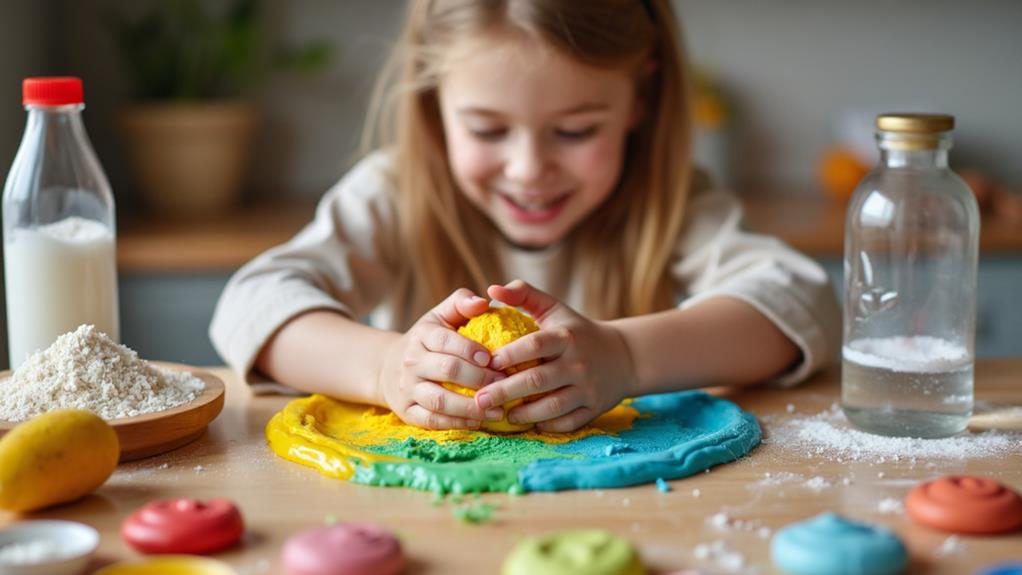
Creating customized playdough with various colors, scents, and textures can be enjoyable, but occasional issues may arise. Here are some troubleshooting tips to help ensure your playdough turns out perfect every time.
If your playdough is too sticky, gradually add flour, one tablespoon at a time, until the consistency improves. Mix well after each addition to avoid over-flouring. For an uneven texture, ensure all dry ingredients are thoroughly mixed before adding liquids to prevent clumping and achieve a smoother dough. If your playdough is too crumbly, adding a small amount of oil can enhance its elasticity and texture. Start with a teaspoon and knead well, adding more if necessary.
Adjusting the color can be tricky. Add food coloring gradually during kneading to achieve the desired shade and ensure even distribution throughout the dough. If your playdough dries out over time, kneading in a few drops of water can restore its softness and pliability. With these troubleshooting tips, you can create perfect playdough every time!

